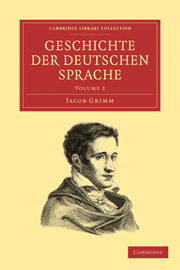Book contents
- Frontmatter
- XXI HESSEN UND BATAVEN
- XXII HERMUNDUREN
- XXIII DIE NIEDERDEUTSCHEN
- XXIV FRIESEN UND CHAUKEN
- XXV LANGOBARDEN UND BURGUNDEN
- XXVI DIE UBRIGEN OSTSTÄMME
- XXVII SCANDINAVIEN
- XXVIII DIE EDDA
- XXIX GERMANEN UND DEUTSCHE
- XXX RÜCKBLICK
- XXXI DEUTSCHE DIALECTE
- XXXII DER ABLAUT
- XXXIII DIE REDUPLICATION
- XXXIV SCHWACHE VERBA
- XXXV VERSCHOBNES PRAETERITUM
- XXXVI DIE VOCALE DER DECLINATION
- XXXVII DER INSTRUMENTALIS
- XXXVIII SCHWACHE NOMINA
- XXXIX DER DUALIS
- XL RECHT UND LINK
- XLI MILCH UND FLEISCH
- XLII SCHLUSS
- Bemerkte druckfehler, lies
XXV - LANGOBARDEN UND BURGUNDEN
Published online by Cambridge University Press: 29 August 2010
- Frontmatter
- XXI HESSEN UND BATAVEN
- XXII HERMUNDUREN
- XXIII DIE NIEDERDEUTSCHEN
- XXIV FRIESEN UND CHAUKEN
- XXV LANGOBARDEN UND BURGUNDEN
- XXVI DIE UBRIGEN OSTSTÄMME
- XXVII SCANDINAVIEN
- XXVIII DIE EDDA
- XXIX GERMANEN UND DEUTSCHE
- XXX RÜCKBLICK
- XXXI DEUTSCHE DIALECTE
- XXXII DER ABLAUT
- XXXIII DIE REDUPLICATION
- XXXIV SCHWACHE VERBA
- XXXV VERSCHOBNES PRAETERITUM
- XXXVI DIE VOCALE DER DECLINATION
- XXXVII DER INSTRUMENTALIS
- XXXVIII SCHWACHE NOMINA
- XXXIX DER DUALIS
- XL RECHT UND LINK
- XLI MILCH UND FLEISCH
- XLII SCHLUSS
- Bemerkte druckfehler, lies
Summary
Diese beiden völker, welchen es schwer ist eine andere stelle anzuweisen, fasse ich zusammen, da sie miteinander gemein haben, dass sie aus dem norden in den süden vorgedrungen hier allmälich ihrer deutschheit verlustig giengen. sie erreichten keine küste, kein eiland, wo sich ihre eigne, angestammte art hätte erhalten können.
Langobarden nennt uns zuerst Strabo s. 290 neben Hermunduren, beide als einen theil des grossen suevischen volks und jenseits der Elbe, d. h. auf der linken seite des stroms wohnhaft. muss man nun die Hermunduren der mittleren Elbgegend überweisen, so bleibt für die Langobarden die niedere. Plinius und Dio geschweigen ihrer. Tacitus, nachdem er die Semnonen als hauptvolk der Sueven geschildert und ihre ansehnliche macht hervorgehoben hat, fährt cap. 40 fort: contra Langobardos paucitas nobilitat; plurimis ac valentissimis nationibus cincti non per obsequium, sed proehis et periclitando tuti sunt. gegenüber im osten müssen ihnen Semnonen und vielleicht noch andere nordöstliche Sueven, im süden Hermunduren, im westen Cherusken, im norden Haruden und Chauken gesessen haben. Vellejus 2, 106 Tibers heerzug in Germanien vom j. 5 berichtend stellt sie auch gleich unmittelbar nach den Chauken: receptae Chaucorum nationes. omnis eorum juventas infinita numero, immensa corporibus, situ locorum tutissima traditis armis … ante imperatoris tribunal. fracti Langobardi, gens etiam germana feritate ferocior. denique, quod nunquam antea spe conceptum, nedum opere tentatum erat, ad quadringentesimum milliarium a Rheno usque ad flumen Albim, qui Semnonum Hermundurorumque fines praeterfluit, romanus cum signis perductus exercitus.
- Type
- Chapter
- Information
- Geschichte der deutschen Sprache , pp. 682 - 708Publisher: Cambridge University PressPrint publication year: 2009First published in: 1848



